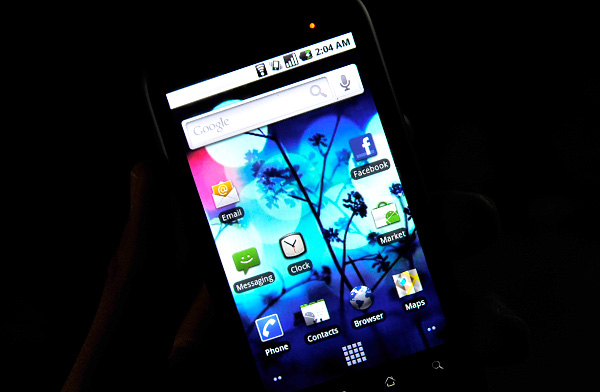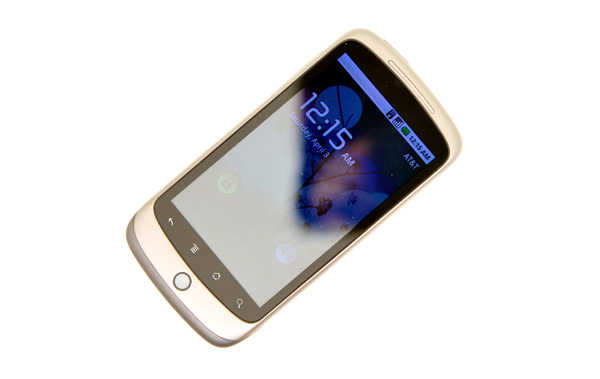Anand's Google Nexus One Review
by Anand Lal Shimpi on April 3, 2010 3:40 AM EST- Posted in
- Smartphones
- Mobile
The Display, My Love, the Display
If there’s one aspect of the Nexus One that makes the iPhone 3GS feel really dated it’s the display. Let’s look at the basic specs:
| Google Nexus One vs. Apple iPhone | |||||
|
Apple iPhone 3GS (ARM Cortex A8)
|
Google Nexus One (Qualcomm Snapdragon QSD8250)
|
||||
| Screen Technology | LCD | Active Matrix OLED | |||
| Screen Diagonal | 3.5" | 3.7" | |||
| Resolution | 320 x 480 | 480 x 800 | |||
| Pixels per Inch | 163 ppi | 252 ppi | |||
For very similar screen sizes (the Nexus One is narrower but longer than the iPhone), Google offers a huge increase in resolution. It makes sense given that the iPhone 3GS is still using the same resolution panel as the first iPhone back in 2007.
Recently Luke Hutchison published an excellent article at Ars Technica explaining the subpixel makeup of the Nexus One’s display. Most display technologies we’re used to reproduce colors by using a combination of red, green and blue. Instead of evenly distributing RGB subpixels across the display, the Nexus One has a combination of RRG or GBB for each pixel. This optimization is put in place most likely to reduce manufacturing cost or increase lifespan of the display.
Either way, you’re not getting complete color data on a per pixel basis. Now I won’t get into the argument of whether or not Google should call it a 480 x 800 display. It technically has that many pixels, it’s just that their makeup is a bit odd.

Google also does some pretty standard tricks to make the display look even more impressive. You get oversaturated colors and the usual trickery you can find in the TV section at Best Buy. Whites on the Nexus One aren't quite white but rather a cool blue and reds are often too red.
Compared to the iPhone, indoors, the Nexus One display is just incredible. If there are two things you could describe the Nexus One display as they would be: high contrast, and sharp. Indoors, and above 50% brightness, it’s honestly the best looking display I’ve ever seen on a smartphone. The colors are ridiculously vibrant and they pop because of the super deep blacks.

It really looks that contrasty.
The AMOLED display has no backlight, and thus it’s far more power efficient to display lots of black than it is to display bright whites. For this reason many of the applications use black backgrounds. For example, here’s the email app in Android vs. the email app in iPhone OS:
|
Google Nexus One
|
Apple iPhone 3GS
|
 |
 |
Given that Android is a fairly mainstream OS and not a pornsite, white text on a black background is generally unexpected. Unexpected, but not more difficult to read. The high resolution and incredibly contrasty AMOLED display make sure of that.

In direct sunlight, the lower part of the picture above is what the Nexus One looks like
Outdoors it’s another story entirely. In direct sunlight, the display is mostly useless at its default brightness settings. With the brightness cranked all the way up it’s still washed out but at least legible. Which brings me to my next point. The auto brightness control on the Nexus One is frustrating.

It automatically adjusts display brightness based on ambient light, but it generally picks a brightness that’s too low for my tastes. I just ended up disabling the automatic control and picked something that was around 50 - 100% brightness depending on what I was doing with the phone. I would like the option to have the auto brightness control pick settings that are a little less conservative.
Touch the Screen
Touchscreens have gotten much better over the past couple of years since the iPhone’s introduction. The Nexus One’s touchscreen is very close to as responsive as the iPhone’s but with some annoying issues. There are some situations where holding the Nexus One in one hand and swiping with my thumb won’t let me swipe between screens, and other similar accuracy issues. Getting the home bar buttons to recognize taps is also a pain at times. The touchscreen is definitely usable, just not as good as the iPhone's.










95 Comments
View All Comments
xtremevarun - Saturday, April 3, 2010 - link
Reviews of Nexus One on other sites were not as comprehensive as on Anandtech. You guys really explored all the features. Apple needs to do a major refresh to iPhone. And I do see Android becoming a major, major OS for phones if it's not already. WinMo7 also looks great. Good that competition is hotting up against the iPhone.xxNIBxx - Saturday, April 3, 2010 - link
What about Samsung's Bada OS? Samsung Wave s8500 beats the living crap out of all those Snapdragon devices. Also Samsung will release i9000 Galaxy S, which has pretty much the same hardware as with s8500, except it runs Android. Hardware wise, these 2 are the best phones in the world. Snapdragon is old news.Iphone 4g, which will come out in 2 months, will most likely use apple's a4, which from what i hear, is probably identical to samsung's 1ghz cpu(same cpu/gpu)/
sprockkets - Saturday, April 3, 2010 - link
If you receive a call over BT, does it1. Play the ringtone over the headset?
2. Play it on the headset only or both the speaker and headset?
3. Announce CID over the headset or even just the speaker?
sushantsharma - Saturday, April 3, 2010 - link
Looks OK! But usability should not go for a toss! Or I am missing it and it is there?Chloiber - Saturday, April 3, 2010 - link
"It's got a Qualcomm Snapdragon QSD8650 SoC"Thought the Nexus One (and the HTC Desire) use a Snapdragon QSD8250?!
Anand Lal Shimpi - Saturday, April 3, 2010 - link
You are correct :) Fixed!Take care,
Anand
Karl Brown - Saturday, April 3, 2010 - link
I will be receiving my Sony X10 on Tuesday.I hope the Sony will offer enough of the Nexus One's functionality to not make me regret not waiting longer for the Nexus One to become available in the UK.
jasperjones - Saturday, April 3, 2010 - link
Thanks for the very thorough review. The one area were the review lacks depth is audio and video playback and syncing. Differences in this area are striking imo:1.) If you don't use iTunes as an iPhone owner, you're pretty much SOL. The Nexus One I could sync with iTunes using DoubleTwist. But I don't like iTunes. I can just use Explorer or Windows Media Player or Songbird (1.7 beta) to sync instead. The latest Songbird builds do an amazing job (they even converts WAV and FLAC files on-the-fly).
2.) Formats. I like that the the Nexus One supports OGG. FLAC support is coming (AFAIK it got added to trunk some time ago--idk if users will see it in FroYo or Gingerbread) Plus the Nexus One gives me everything the iPhone has (including M4A).
3.) The media player. I hate to admit it as a current Nexus One and previous iPhone owner, but here the iPhone with its iPod app wins hands down. The UI of the iPod app is infinitely more intuitive, whereas things such as playlist generation are a pain on Android (everything takes far too many clicks).
Because of 3.), I think the overall win in this category goes to the iPhone.
bstewart - Saturday, April 3, 2010 - link
Outstanding review - really enjoyed your detailed assessment of the Nexus one compared to the IPone and Palm Pre. I have read a number of reviews on the Nexus one lately determining if it is the right device for me or not. After reading this review I am certainly more inclined to purchase it than before; especially based on it's pros and cons versus the IPhone. Thanks!Brian
cj100570 - Saturday, April 3, 2010 - link
All in all I'm not feeling this review. There was way to much time spent comparing the Nexus to the iPhone. And your complaints about the notification system used by Android is just asinine. I'm the former owner of both an original and 3G iPhone and Android simply puts the iPhone OS to shame. The iPhone had it's 15 minutes of fame but it's time to face facts that Apples way of doing things is the biggest problem the iPhone has. As a smartphone it is a #FAIL. Sure it sells well but the honest truth is that most people buy it because it's an Apple product and because of all the apps, 80% useless, that Apple and AT&T trot out as the big selling point.